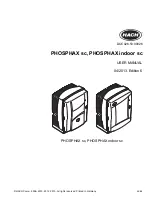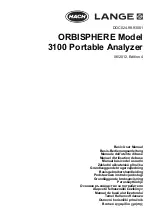
LPR Meter
Handbook
Page 7
External Control Mode
Conversion of Reading to
Corrosion Rate
this output may move outside these limits to anywhere in
the +/- 15V range. Although the circuit is designed to
normally give a positive output, again, under certain
conditions, (test electrode potential drift etc) it may be
negative.
Since the second output is generated by a digital to analog
converter, it is somewhat more predictable, being always
the 0 to 2.048V range.
The Main Control Unit indicates the measurement by a logic
low input on the GO line. This causes the processor to
initiate the measurement and polarisation sequence.
Polarisation is then applied to the cell as long as the GO line
remains low. The RUN output is set high when the cell is
connected to the circuitry (RUN relay closed). The DONE
output is set high when the current measuring amplifier
output and the range indicator outputs are valid, it returns
low during any autoranging. The output of the current
measuring amplifier always reflects the current going to the
test electrode. The DAC2 output is set when the GO line is
released to high to reflect the cell current at that time.
The Outstation LPR board measures the current required to
polarise the test electrode anodically by 20mV. Conversion
to actual corrosion rate may be carried out as follows:
The voltage at the output of the current measuring amplifier
is the voltage drop across the current measuring resistor.
By Ohm’s law:
reading in mV/range = polarisation current in µA.
This is the applied current l
applied
(or more accurately,
Δ
l
applied
).
The linear polarisation resistance measurement technique
(LPR) relies on a measurement of the slope of the current
vs. voltage response of the corroding interface at or near its
natural free corroding potential. It can be shown that this
slope,
Δ
l
applied
/
Δ
E), is related to the corrosion current by the
Stern-Geary equation:
⎟⎟
⎠
⎞
⎜⎜
⎝
⎛
+
×
Δ
Δ
=
a
c
a
c
applied
corr
E
I
I
β
β
β
β
3
.
2
1
where
β
c
and
β
a
are the cathodic and anodic Tafel slopes.
For practical purposes the equation can be simplified to:
p
applied
corr
R
B
b
E
I
I
=
×
Δ
Δ
=
Содержание BF225
Страница 1: ...LPR Meter Handbook...
Страница 11: ...LPR Meter Handbook Page 9 5 LPR Standard...





























